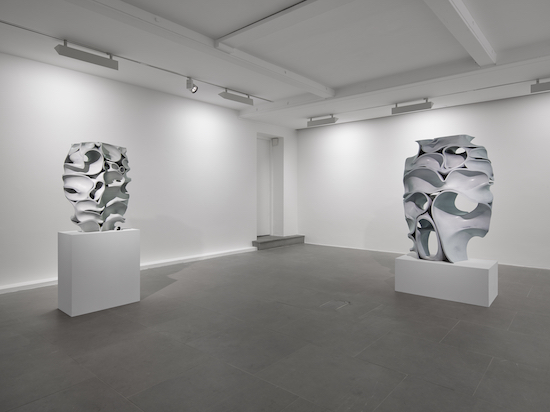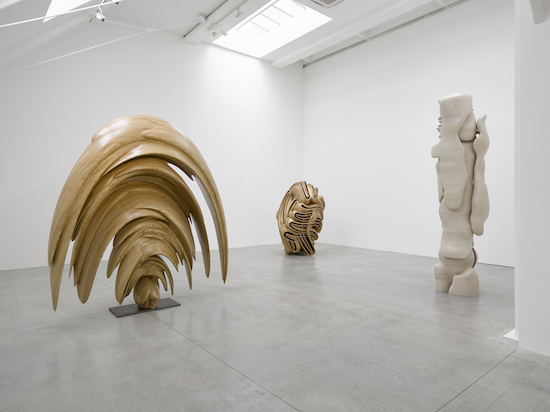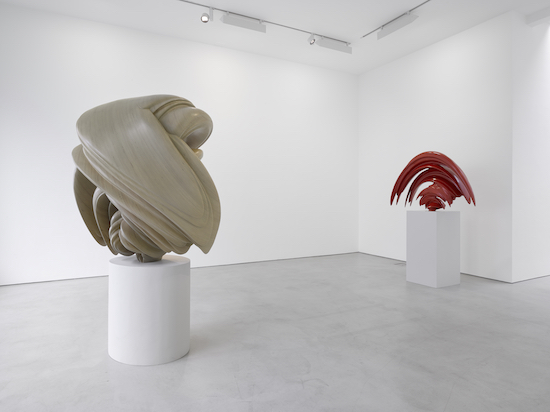“We don’t make very interesting things, human beings.” Tony Cragg is disappointed with the world and the way it looks. “Look at this room,” he says to me. “It’s white, grey, straight-edged, quadratic. Boring! Look at the cities! They’re so boring. One city after another, always the same damn window.” He starts gesturing about the room, expressing his frustration with the design of every object. “I can find that window in every part of the world. And the same telephone, the same table, the same books. Everything’s the same. Repetitive and boring and mediocre.”
The way Cragg sees it, it’s part of his job, as a sculptor, to try and do something about it. Smarten the place up a bit. It’s a task he takes very seriously. “Everything we have in our head has come from the outside world,” he explains. “So if that is the case, then it’s really – evidently – very important what the material is that is around us. That’s the ultimate thing.”
We’re sitting in a meeting room above the Lisson on Bell Street, the London gallery that has represented Cragg for the past four decades. It is the eve of his new show opening, his fourteenth with the gallery. Downstairs (and in the Lisson’s other space, a few doors down the road), some ten different rooms are filled with new works, each one more wild and peculiar than the last. They look like inscrutable machines from extraterrestrial worlds where the line between the organic and the mechanical is considerably more porous than our own, like the fossils of sublime processes frozen in time, like atoms bonding or cancer cells metastasising in extreme close-up. Of all things, I am reminded most of Frank R. Paul’s illustrations on the covers of Hugo Gernsback’s Amazing Stories magazines. What absolutely none of them look like is “white, grey, straight-edged … repetitive and boring and mediocre.”
A former Turner Prize winner who was received official honours in three different European countries, Tony Cragg is one of Britain’s most esteemed and respected sculptors. If you have been to visit the new Tate Modern Switch House building that you can’t have failed to see his Stack from 1975, a perfect two-metre cube of assorted detritus, compressed together by ill-matched planks of wood. It resembles a cross-section view of geological strata, except that every layer is composed of man-made junk. Now that everyone from left-wing media theorists like McKenzie Wark and Joana Zylinska, to august institutions like the International Congress are declaring the arrival of the anthropocene, a new epoch defined by the effects wrought upon the earth by humanity, the return of Cragg’s work to public view could scarcely be more timely.
“I’ve always had an interest in geology,” Cragg tells me when I mention this. “As a small boy I always collected fossils and rocks. The idea that looking at a landscape, you know exactly what’s under the landscape – it’s very, very exciting to know what’s underneath it. We only ever really see the surface of everything, from light reflecting off the surface onto our eye, but my whole thing is that I think we always have this psychological pressure to see behind that surface. I think that’s the basis of sculpture for all time.”

Installation view: ‘Tony Cragg’, Lisson Gallery, London, 1 October – 5 November, Photography by Jack Hems © Tony Cragg, Courtesy Lisson Gallery
Born in Liverpool in 1949, by the age of 17 Cragg was working as a lab technician at the National Rubber Producers’ Research Association in Welwyn Garden City. He took to drawing in his spare time. Eventually he left to pursue his hobby full-time. “Going to art school in 1969,” he says, “I wasn’t interested in sculpture. I wanted to draw. That was my interest. But when I went to Wimbledon, the situation in sculpture was so dynamic. There was [Henry] Moore and [Anthony] Caro and after Caro there was already Gilbert & George and Richard Long. And that was just Britain! The dialogue was amazing.”
There is something almost punk avant la lettre about Cragg’s early approach to sculpture. “I just wanted to make very, very simple things,” he says. “No skills. That was important for me. Not to have a skill. I didn’t know anything about sculpture. I just wanted to see what one could do with materials.” So he started experimenting with simple procedures: tying knots in things, making piles of them, stacking.
By the early ’70s, Cragg had developed a fascination with American minimalists like Robert Morris and Donald Judd. “It looked,” he tells me, “almost like a sort of full stop in the history of sculpture.” It was finally a trip to New York, meeting his heroes, that decided him against it. He realised how far apart he was from them in sensibility. “It was another generation,” he says now. “People living in this super-minimal landscape of New York, with these shiny surfaces and tall structures with straight edges. At the same time they were dropping bombs on people living in bamboo houses. It just seemed so crazy, the whole thing.”
“So I wanted to do something that was earthy and simple and related to nature,” he continues. “That’s where that started. Where the Stacks came from.”

Installation view: ‘Tony Cragg’, Lisson Gallery, London, 1 October – 5 November, Photography by Jack Hems © Tony Cragg, Courtesy Lisson Gallery
Dressed in a button-down, short-sleeved shirt and little round glasses, Cragg comes across at times more like a scientist or engineer than an artist. His thoughts stray very quickly from the eminently practical to the almost metaphysical with barely a breath between. His manner is animated and expansive, comfortable in his own skin without ever seeming arrogant. Despite many years living in mainland Europe, he still takes his tea with milk and sugar.
Next year he will have his largest UK exhibition to date at Yorkshire Sculpture Park, a 500 acre site in West Bretton, near Wakefield. I’m curious to know what difference he thinks it makes, to have his work out in the wild, instead of the controlled indoor environment of the gallery. But for the most part he seems more concerned with the practicalities of what can be left outside. “Most stones don’t do very well outside,” he insists. “You can’t put wood. You can’t put chocolate out there. So that’s a limit. And then the scale, the size, the stability – because you can’t have it rolling around, you know, doing damage to people.”
But take, say, this particular work here, I say gesturing to a picture in the catalogue for the present show, that could go outside.
“Yeah…” he says slightly grudgingly. “That could go outside.”
But would it change for you if it was outside? Its meaning? Its emotional resonances?
“Well,” he says with a smile, “I think what changes is the outside.”
Tony Cragg is at the Lisson Gallery, London, until 5 November. His show at Yorkshire Sculpture Park opens in March 2017


